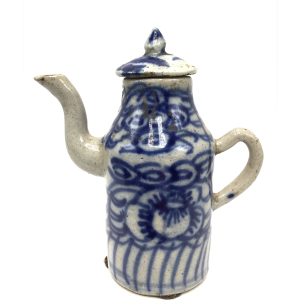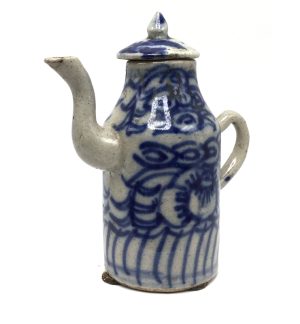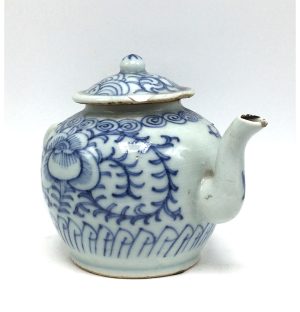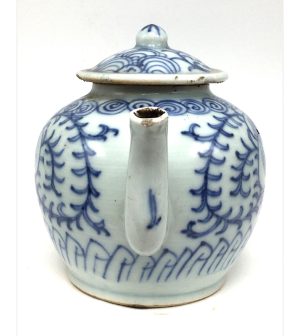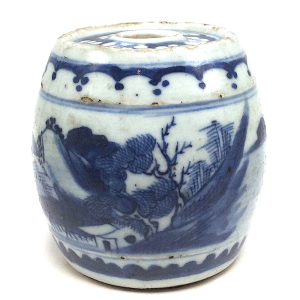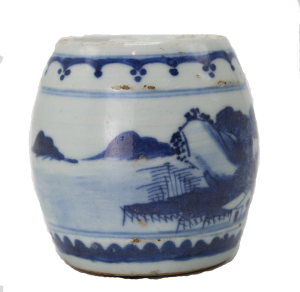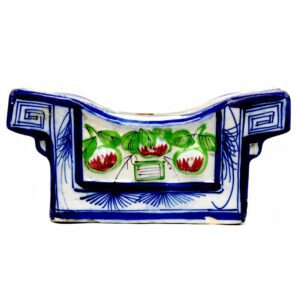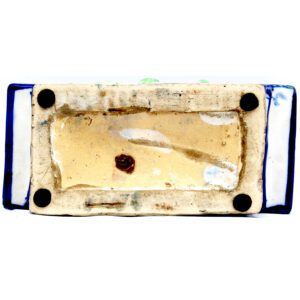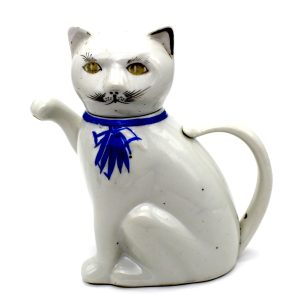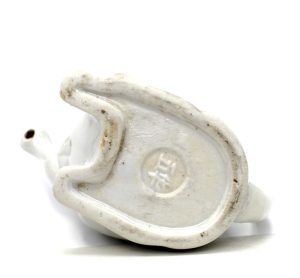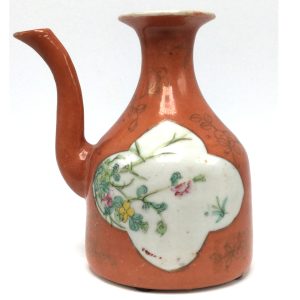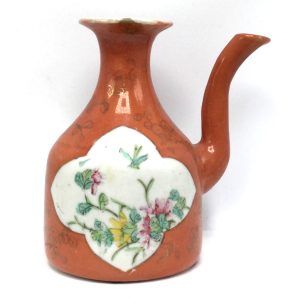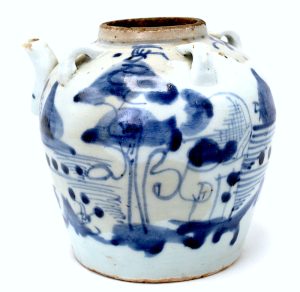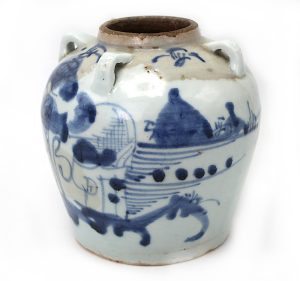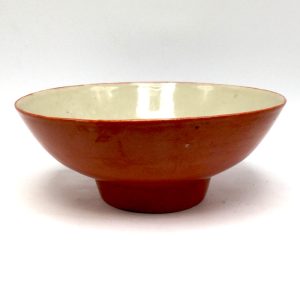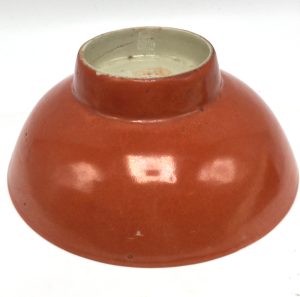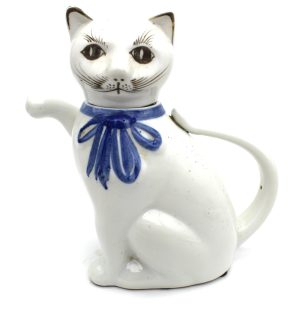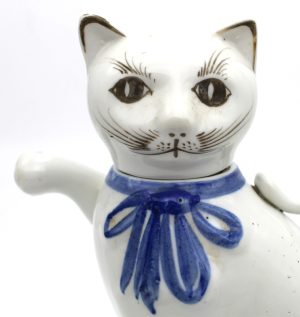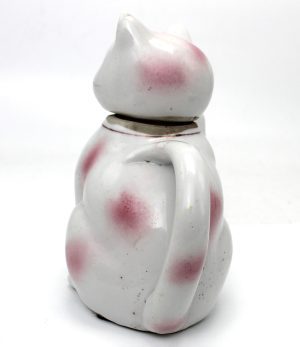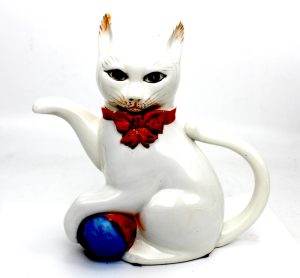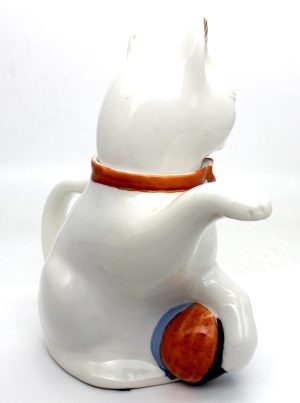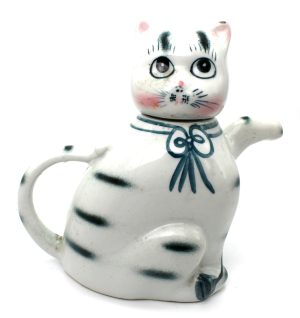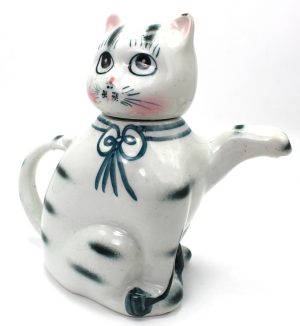Showing 1–12 of 19 results
-
Sale!


$135.00 Original price was: $135.00.$95.00Current price is: $95.00.
H: 5.25″ W: 4.625″ D: 2.375″ | FREE SHIPPING WITHIN CONTINENTAL U.S.
Charming miniature pitcher probably used in a restaurant or home kitchen as a dispenser for soy sauce, oils or other liquids. Elegant shape, covered with chrysanthemums, plantain leaves and bindweed vines with lotus bud on top.
-
Sale!


$175.00 Original price was: $175.00.$115.00Current price is: $115.00.
H: 5.25” W: 4.75” D: 2.375” | FREE SHIPPING IN CONTINENTAL US
Small teapot with intricate cobalt blue chrysanthemum and bindweed designs widely used in late 19th century in domestic and export wares. Ball handle on lid.
-
Sale!


$255.00 Original price was: $255.00.$195.00Current price is: $195.00.
H: 3.25” Dia: 3.25” | FREE SHIPPING WITHIN CONTINENTAL U.S.
With its round body covered with a Chinese village landscape, mountains, seas and calligraphic scholar owner’s name, this ceramic brush holder/paper weight was used a scholar’s desk along with pots, brushes, water droppers, boxes, ink stones and other objects and would be perfect on any style desk.
-
Sale!


$115.00 Original price was: $115.00.$105.00Current price is: $105.00.
H: 4″ W: 9.5″ D: 4.5 ” | FREE SHIPPING
Multicolored ceramic opium pillow, hand-painted green and red florals, fruits and vases in relief, blue cobalt border. Top and bottom seals to approve for export as antique.
-
Sale!


$145.00 Original price was: $145.00.$125.00Current price is: $125.00.
Ht: 6.25” W: 5.5” D: 3.25” | FREE SHIPPING WITHIN CONTINENTAL U.S.
The Chinese characters within a circled seal in the mold on the bottom indicate this teapot is an antique. As the thin ribbon blue collar as wishes for long life, it is a perfect birthday gift. Recommended for decorative use only.
-
Sale!


$235.00 Original price was: $235.00.$195.00Current price is: $195.00.
H: 4.875″ W: 4.5″ D: 3.25″ | FREE SHIPPING WITHIN CONtINENTAL U.S.
Elegantly shaped porcelain ewer with graceful spout, saffron-colored glaze, quatrefoil panels and hand-painted floral designs within a gold frame with sinuous gold leaf vines.
-
Sale!


$145.00 Original price was: $145.00.$105.00Current price is: $105.00.
H: 5” W: 5.25” D: 4.5” | FREE SHIPPING within continental US.
Blue and white ceramics like spouted jar with four loops, were used in home kitchens and restaurants to hold oil, sauces, soy or other liquids. Decorated with country scene in a landscape with by tall trees.
-
Sale!


$135.00 Original price was: $135.00.$110.00Current price is: $110.00.
H: 2.5” Dia: 5.75” | FREE SHIPPING WITHIN CONTINENTAL U.S.
Beautifully shaped footed porcelain bowl, thinly crafted with a coral saffron glaze on the outside on a deep foot. Fading red stamped seal of an unknown kiln on bottom. Likely from the Tongzhi Period 1862-1874.
-
Sale!


$145.00 Original price was: $145.00.$125.00Current price is: $125.00.
H: 7” W: 7” D: 3.5” | FREE SHIPPING IN CONTINENTAL US
Porcelain cat teapot removable head, sinuous tail handle. Beautifully hand-painted whimsical ribbon-like blue collar, dangling ornamental bow, and the black accents. Likely Qing Dynasty circa 1900-1920.
-
Sale!


$135.00 Original price was: $135.00.$115.00Current price is: $115.00.
H: 5.5″ W: 3″ D: 3.375″ | FREE SHIPPING WITHIN CONTINENTAL U.S.
Antique porcelain teapot, removable head, tail handle, and spout paw. Hand painted design with ribbon-like gold collar and dangling ornamental bow symbolizing long life. Great gift, recommended for decorative use only.
-
Sale!


$145.00 Original price was: $145.00.$125.00Current price is: $125.00.
H: 8” W: 8” D: 3.75” | FREE SHIPPING IN CONTINENTAL US.
Beautifully hand-painted whimsical cat tea pot with red collar ribbon, ornamental bow, and ball under left paw. Black, orange, red and blue accents on face, ears, head, paws and ball. Bottom double stamped seal.
-
Sale!


$145.00 Original price was: $145.00.$125.00Current price is: $125.00.
H: 7” W: 8” D: 3.625” | FREE SHIPPING WITHIN CONTINENTAL U.S.
Rotund porcelain teapot with removable head. With her pink highlights, round wide eyes, feathered brows and 3 part ribbon with bow she appears to be an affectionate female lap cat.
End of content
End of content

